
On Friday the Cairngorms National Park Authority Planning Committee is due to consider the application by Natural Retreats, financed by Highlands and Islands Enterprise, for a dry ski slope at Cairngorm (see here). It hard to conceive of a more inappropriate development but officers have recommended that Board Members accept the proposal. The issues are so central to what the National Park should be about that, this week, Parkswatch will run a series to posts about Cairngorm. This post takes a look at the outcome to date of the last planning application which the CNPA approved at Cairngorm, the retrospective application for a track at the Shieling (see here). Last week I went with some other people to have a look at how it looks now and what has happened since.
The Shieling track was created because, in removing the old tow and constructing the new Shieling uplift, Natural Retreats and its contractor failed to adhere to the plans agreed by the CNPA and did not retain the vegetation and soils necessary to restore the entire area as had been promised. The solution was to create a new track which Natural Retreats, when forced eventually to apply for planning permission, claimed was absolutely necessary for maintenance purposes. This claim was rubbish but unfortunately the CNPA swallowed it. In the summer I saw a nice example from Switzerland which illustrates this:
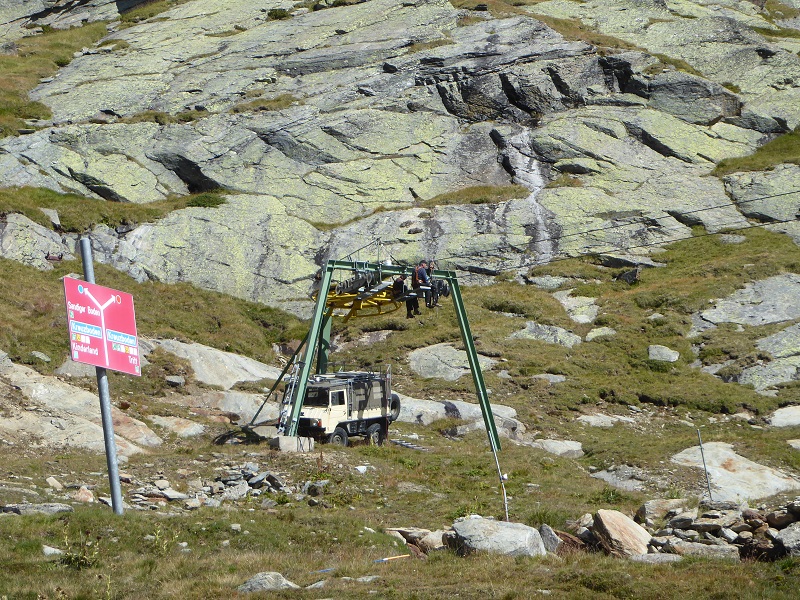
The Shieling track itself, 18 months later, looks better then it did:


The erosion that was so evident 18 months ago has been halted, for the timebeing at least, through seeding of the bare ground and through the insertion of ugly metal culverts (why could not the CNPA have insisted on stone water barriers here as are used on the footpaths through the ski area?). This recovery has been helped by very little vehicle use, which has enable grass to colonise the track lines – if vehicles are not being driven here regularly that rather supports the view that there was no need for this track.
Walking up the track the biggest eyesores are the plastic culverts and artificial boulder fields created by the construction works. These are totally out of place in this landscape:

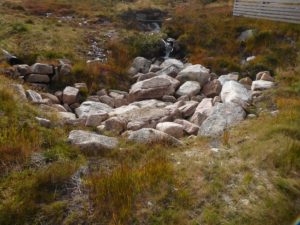

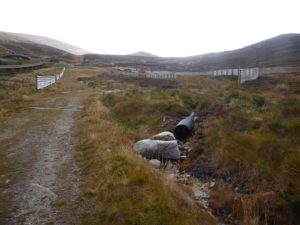
The original planning application for the Sheiling tow referred to new culverts to channel the Allt Choire Chais, which the Construction Method Statement stated would be carefully covered over, but nothing about these culverts or the other plastic culverts that have inserted in other areas outwith the area granted planning permission:
 Strangely, the landscape assessment in the CNPA Planning Committee Report on the Shieling hill track made no mention of culverts or boulderfields but instead focussed on earth profiling at the top and bottom of the tow which it said looked artificial and out of place in this landscape. If that was out of place what about the plastic pipes? A serious omission. While its not too late for the CNPA to take enforcement action under their original consent – and I think it should do so on the grounds that none of the features pictured here were in the plans – the lesson here is that in dealing with bodies like Natural Retreats you need to insist on very detailed specifications and plans if you want to prevent landscape damage.
Strangely, the landscape assessment in the CNPA Planning Committee Report on the Shieling hill track made no mention of culverts or boulderfields but instead focussed on earth profiling at the top and bottom of the tow which it said looked artificial and out of place in this landscape. If that was out of place what about the plastic pipes? A serious omission. While its not too late for the CNPA to take enforcement action under their original consent – and I think it should do so on the grounds that none of the features pictured here were in the plans – the lesson here is that in dealing with bodies like Natural Retreats you need to insist on very detailed specifications and plans if you want to prevent landscape damage.
The main condition attached to the CNPA’s retrospective consent for the shieling track was that Natural Retreats should plant trees along the strip of land between the tow and the funicular as compensation for the track. It was good to see last week that this appears to have been done – we didn’t count the number of trees! – and done well:
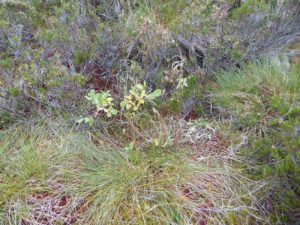


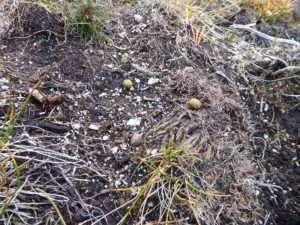
A difficult choice had to be made here, use plastic tree protection sleeves, which tend to leave litter all over the landscape or risk a proportion of the trees being lost to grazing animals including mountain hare. Having decided not to use plastic sleeves, which I think was the right decision although its been followed by inevitable tree loss, allowing open plastic culverts to remain seems even more bizarre. That however sums up the contradictory way our mountains are being managed, great care taken on the one hand (footpath construction, some native tree planting), a complete disregard for that same environment on the other (hill tracks and other developments).
This dichotomy between care and disregard for the mountain was demonstrated further up the hill:
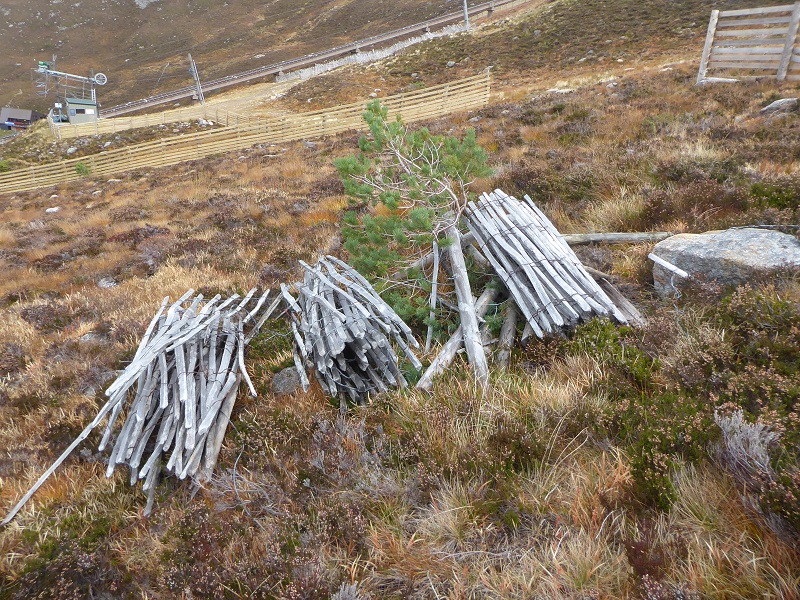
One wonders whether the trees that have been planted by the funicular have any chance when the management at Natural Retreats allows this to happen.
The mismanagement of Cairngorm continues but can it be addressed through planning?
We came across the crushed tree on our way to look at some white bags which I had been informed had appeared on the slope adjacent to the track up Coire Cas and below the top of the Fiacaill Ridge poma:

They were full of boulders which had been taken from the boulder fields around them and waiting to be transported by helicopter:

While a certain amount of care has been taken with the lifting of the boulders, that certainly isn’t the case for the area where they appear destined, the Fiacaill Poma uplift track:

There is no planning application on the Highland Council Planning Portal for this work but part of involves the installation of new electric cabling. Highland Council had previously told Natural Retreats that they did not require planning permission for such work on the Car Park tow and I suspect therefore that if Natural Retreats has informed them about this work Highland Council have said it does not require planning permission. While you might think “thank goodness some work is being undertaken to keep lifts apart from the funicular in working order”, the problem is the work appears far more than simply replacing an electric cable:

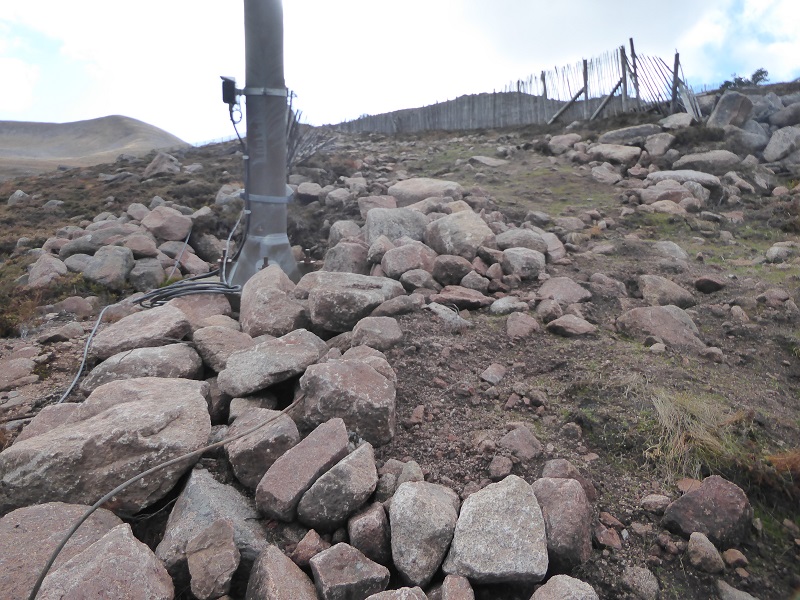 Indeed, it would appear that something else is going on – one explanation is Natural Retreats staff have taken the opportunity to re-profile the whole slope.
Indeed, it would appear that something else is going on – one explanation is Natural Retreats staff have taken the opportunity to re-profile the whole slope.
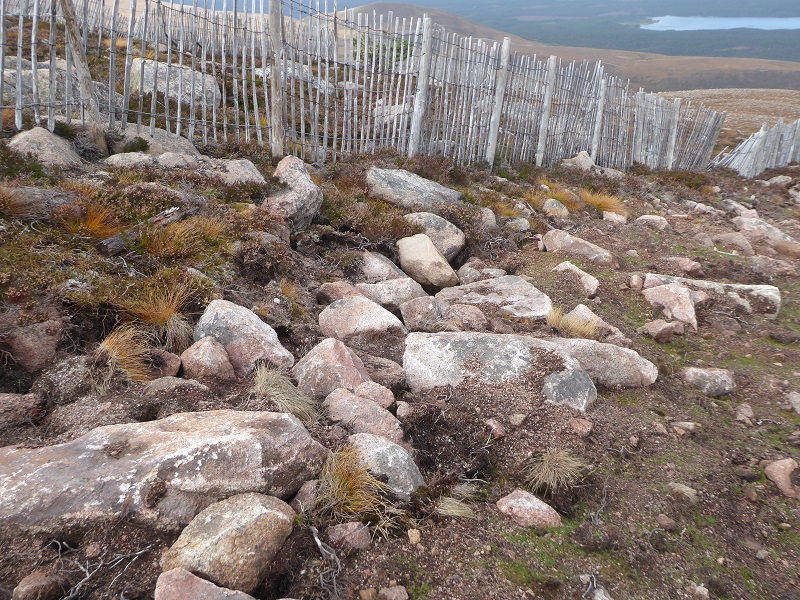 And the piles of boulders in the white bags below are part of this bigger project.
And the piles of boulders in the white bags below are part of this bigger project.
Its worth recalling that when the funicular was constructed, every boulder was supposed to be marked and replaced from where it had been lifted. Now apparently boulders are being moved all over the mountain without any permissions at all.
The thing though that really sickens me about this is IF boulders were needed to “improve” or “shore up” the uplift track or other ski slope, then there are ALREADY heaps of boulders that Natural Retreats has stacked up elsewhere on the mountain:


So why not use these boulders rather than modify a boulder field that has lain in the Coire since the ice retreated?
Perhaps its because its a shorter helicopter journey?
What needs to happen
HIE need to clarify publicly whether they, as the landowners, have consented to all the works associated with Fiacaill Poma recabling and whether they have consented to the boulders in the bags being moved. If not, they should tell Natural Retreats to replace the boulders and would in my view be justified in terminating their lease with Natural Retreats. If they have consented, that is more evidence that they are totally unfit to remain as owners of Cairngorm.
Our other public authorities also need to start taking a far more proactive role in ensuring Cairngorm is properly managed. SNH, who was involved in ensuring the funicular had the minimum impact possible, should be insisting the standards used then should be applied to the whole of Cairngorm now instead of looking the other way. Highland Council and the CNPA should be using all planning powers at their disposal – enforcement action both against the outstanding eyesores in the Shieling tow development and the current work on the Fiacaill poma – would be a start. And SEPA could start taking a serious look at how all the culverts and ditches dug by Natural Retreats have impacted on drainage.
Unfortunately, I don’t expect any of this to happen. The reason why? Well if our public authorities can contemplate a large section of slope by the car park being covered in plastic, they are hardly likely to be concerned about the issues I have highlighted here.
This won’t change without enormous public pressure – thankfully with the funicular fiasco that may be about to happen. A small sign is the Aviemore and Glenmore Community Trust have run a poll on the dry ski slope and so far out of 656 votes 83% have responded no (see here).